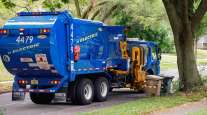Senior Reporter
DHL Plans Third Air Cargo Hub in California

[Stay on top of transportation news: Get TTNews in your inbox.]
WASHINGTON — While concerns are growing about a slowing international economy, officials with international air express carrier DHL Express say in late 2023 or early 2024 they will expand their presence in the United States by adding a third California air hub.
A specific site was not announced, but the company already has air hubs in Los Angeles and San Francisco.
Disclosure of a new facility comes just weeks after DHL announced it had moved into a new 40,000-square-foot sorting center in Redondo Beach, just miles from its LAX Gateway. The company said this center is 60% larger than its previous location.
In a wide-ranging interview with Transport Topics, Greg Hewitt, CEO of DHL Express U.S., said the leadership is doubling down on its GoGreen Plus program, announced by its parent company Deutsche Post DHL Group in late February, with the goal of being a net-zero emissions company by 2050.
“I think when Frank Appel (CEO of Deutsche Post DHL Group) laid out the vision of by 2050 being a zero-emissions company, it was based on his recognition and admission that as an industry we have to admit we’re polluters, that by the very nature of logistics we fly planes, we drive trucks, we pollute the environment,” Hewitt said. “I think we’re hearing from both big companies and small midsize enterprises that sustainability is important to them.”
To reach its goal DHL said it’s working with its customers by allowing them to reduce the carbon emissions associated with their shipments through the use of sustainable aviation fuel.
According to the U.S. Department of Energy, sustainable aviation fuel is a biofuel used to power aircraft that has similar properties to conventional jet fuel but with a smaller carbon footprint. It’s made from renewable biomass and waste resources, which supporters of the fuel say has the potential to deliver the critical performance aspects of conventional Jet A fuel, but with only a fraction of its carbon footprint.

Hewitt by Dan Ronan/Transport Topics
“We see this as the most important step forward improving the environment for what we do. Deutsche Post’s strategy towards 2050 is $8 billion we’ve committed to investments in sustainable innovation. The biggest piece of that is investing in sustainable aviation fuel. So I think we are excited about that,” Hewitt said. “GoGreen Plus is going to enable our customers to buy, just by clicking and choosing to invest and join our pool of purchasing sustainable aviation fuel. And so we literally turned it on last week.”
A 2020 study by the consulting company Roland Berger showed that aviation currently accounts for 3% of global carbon emissions, but with the demand for passenger and cargo flights expected to surge over the next 25 years, in both passenger and cargo flights, aviation’s carbon footprint is expected to increase to as much as 24% of global emissions by 2050.
DHL recently announced that within the next three to four years it will begin flying 12 electric-powered, twin engine regional airplanes, named “Alice,” manufactured by Israeli-based Eviation, capable of flying 440 miles and carrying 2,500 pounds of cargo.
DHL says battery technology has improved to the point where the planes can be sufficiently recharged during the time the planes are on the ramp being unloaded and loaded.
“On the feeder routes, I think we’re going to go the electric route and that will be those, the 12 we will take delivery of in 2027. We want to move to full electric,” Hewitt said. “And on the bigger interconnecting network, the bigger jets, it’s going to be sustainable aviation fuel.”
Last September, Eviation conducted a test flight of the new airplane, with a successful takeoff and eight-minute flight before landing the single-pilot aircraft. Eviation says eventually battery-powered airplanes will be quieter and cheaper to operate per flight hour compared to light jets or high-end turboprops.
DHL also believes there is work to be done to lower carbon emissions on the ground, specifically in its regional and final-mile delivery operations, and the company believes battery-operated delivery vehicles will be the way to get there.
When it announced its zero-emissions goal, the company said it will have 80,000 electric vehicles or 60% of its worldwide fleet on the road by 2030.
“I’m hopeful that the technology is at that inflection point where now we’re going to be able to get bigger vehicles that are electric,” Hewitt said. “This is everything from the local, smaller vans through more of the sprinter style vehicles, and that’s why we need the 250-mile vehicle to play into it.” DHL is partnering with Daimler Truck North America and Penske to reach that lower emissions goal.
Want more news? Listen to today's daily briefing above or go here for more info
Hewitt believes that by giving DHL’s customers options for how they can reduce global emissions, it improves the possibility of being successful in the long run.
“Giving people the option to insert their carbon emissions, giving them a science-based reporting mechanism that they’ll be able to show their shareholders or at least, give them some peace of mind, we think is going to be pretty big and pretty important and we’re excited about that,” he said.
Deutsche Post DHL ranks No. 3 on the Transport Topics Top 50 list of the largest global freight companies. DHL Supply Chain of Westerville, Ohio, ranks No. 12 on the TT list of the Top 100 largest logistics companies in North America.




